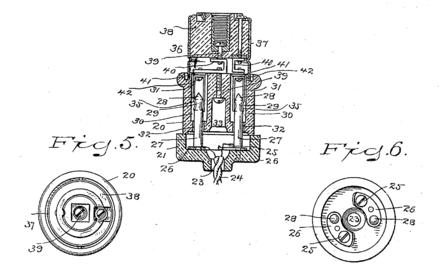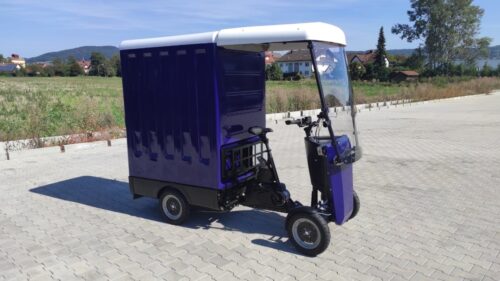You don’t have cables coming out of your walls, you have outlets to plug into. It’s perhaps obvious that this is how the EV market should also work.

Yet, for some odd design reason in America, EV chargers always have cables permanently attached… which in reality means octopus-like chargers are damaged when their ugly, long and floppy cables are stolen.

It begs the question why an EV isn’t designed for a retractable cable like every other major electrical appliance (e.g. oven or dryer). Or have a cable that detaches on both ends, like everyone’s laptop or phone.
In fact, in the EU everyone uses the outlet and brings a cable, meaning anyone can pull their EV up to a light pole on the street and plug in. Easy, reliable, no mess, plus far less risk of failure to charge because a socket design on existing light poles is so much simpler to secure from damage.

The EU will completely outpace the US on EV infrastructure because of such intelligence in quiet and almost hidden distributed power, reflecting the lack of any need for America to slowly roll out large wasteful concentrated “stations” covered in advertisements.
Given 2 lbs of copper runs in a large charging cable, and the rush of copper theft, it makes even less sense that Tesla has been building centralized ugly zones where an attacker can quickly hit a strangely numbered 88 of their cables, to recycle them at around $10-20 each.

Concentrated charging stations into a single area, is a truly dumb concept. Why did anyone ever think this made any sense at all? Centralizing charging stations with all their expensive delicate cables to be dangling and damaged, instead of spreading out simple reliable sockets, are even dumber. Outlets are the future like it’s 1924 again.

Electricity runs practically everywhere today. Trying to undo Westinghouse and go back to Edison’s dream of limited reach is peak ignorance in American history. And what could be more ironic than a company named Tesla doing the exact opposite of what Westinghouse would do?
Westinghouse was horrified by the reports of Kemmler’s execution [by Edison’s cruel designs]. “It has been a brutal affair,” he said. “They could have done better with an ax.”
Even more to the point, Tesla unnecessarily modified EU charging equipment made by Mennekes to put their brand on it. They could have left it a standard Mennekes product instead.

Terrible concepts, terrible designs, terrible operations… that’s the T now in Tesla.
The Houston Police Department tells KPRC 2′s Gage Goulding that 18 of the 19 charging stations had their cables stolen, according to a report that was filed by a Tesla service technician on Monday.
Kind of them to leave one cable behind, I guess? Here’s another case with local analysis included.
Thieves are targeting high-powered Tesla and other EV charging stations and stealing the heavy cable for the copper metal inside. In Vallejo, someone cut cables from nine charging stations…
“You know, they left five charging stations. I’m pretty sure after they racked up, I don’t know what the quantity was, but almost 20 cables with the nozzles. Those are extremely heavy, so I’m imagining that’s all they could haul at one given time,” [retired Marine and former investigator] Beckler said.
This has been going on for years already, with far too little discussion about the basic risk economics. The plug end and cable typically are the most expensive parts of a level 2 EVSE. Here’s the big news from 2022:
…a Tesla Supercharger at a Meijer grocery store in Cincinnati, Ohio, had its cables cut. The post notes that a Tesla mobile technician arrived to repair the cut cables and reportedly told people that this was the third time in a week that cables were cut at the Supercharger station.
So you think Tesla should just keep putting cables back on repeatedly, at huge expense in time and materials, to be cut again? With no changes in design?
Ugh. Enough already.
Two obvious fixes for this, which can rapidly advance the safety and security of EV charging.
- Switch regulations so the US moves away from fixed cables and to an open socket design. Drivers bring their own cables, always (with liquid-cooled DC extreme chargers perhaps being an exception). Have a simple secure door covering the socket, which can be tied to payment. Have a simple electromag cable locking mechanism during charge.
- Switch regulations so the US rapidly pushes charging sockets into existing infrastructure. Light poles on streets and in parking lots, and especially at gas stations, should have standard EV charging sockets. Every gas station should be mandated to provide at least two high speed charging sockets, like how they already have been forced to provide the public restrooms, air and water.
Come on people, this is not that hard to solve. Blink even announced US light pole charging in 2020. Why is every city in America not jumping in this option already?
The pole mounting system is also beneficial in communities transitioning their streetlights into power-efficient LED systems. These LED system lights allow the excess power to operate the pole-mounted EV charging station, turning every streetlight into a potential charging destination.
Get rid of the cables and any light pole is an EV outlet!
Tesla (with the real Tesla rolling in his grave) is doing the Edison thing with EV chargers because they were trying to get everyone stuck into their centrally planned, centrally controlled system of scarcity to enrich one man. That’s more Edison than anything, opposite of the real Tesla.
Of course the Tesla plan, in its ahistorical backwards thinking, is going to fall apart from the most basic known threats. We’ve known since the time of Egyptian pharaohs.
It’s way past time for America to move on step up and get serious about EV infrastructure.



